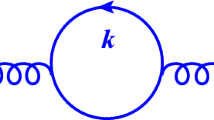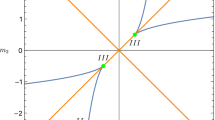Summary
We formulate anomalous chiral and related Ward-Takahashi identities in supersymmetric-gauge theories, by generalizing Fujikawa’s functional-integral method to superspace. Our approach provides a manifestly supersymmetric and gauge-covariant treatment of the superspace Abelian anomalies, and is applicable to chiral- as well as to left-right symmetric theories. Non-Abelian anomalies are also discussed briefly. Superspace Abelian anomalies imply that particular composite operators,i.e. those containing the associatedU 1 currents as a component, exhibit an anomalous supermultiplet structure. We discuss how this leads to various exact relations between scalar and gauge fermion condensates, thereby imposing strong constraints on possible chiral-symmetry realizations in supersymmetric-confining theories.
Riassunto
Si formulano le identità anomale chirali e correlate di Ward e Takahashi nelle teorie di gauge supersimmetrica, per mezzo della generalizzazione del metodo dell’integrale funzionale di Fujikawa al superspazio. Il nostro approccio fornisce un trattamento manifestamente supersimmetrico e di gauge covariante delle anomalie abeliane del superspazio, ed è applicabile a teorie chirali come pure a teorie simmetriche destresinistre. Si discutono anche brevemente le anomalie non abeliane. Le anomalie abeliane del superspazio implicano che particolari operatori composti, cioè quelli contenenti le correnti associate diU 1 come componente, esibiscano una struttura di supermultipletto anomalo. Si discute come ciò porti a varie relazioni esatte tra scalari e condensati di fermioni di gauge, imponendo cosí forti vincoli sulle possibili realizzazioni di simmetria chirale nelle teorie a confinamento supersimmetrico.
Реэюме
Обобшая метод функционального интегрирования Фуджикавы на суперпространство, получаются киральные тождества и тождества, родственные тождествам Уорда-Такахащи, в суперсимметричных калибровочных теориях. Предложенный в зтой работе подход для абелевых аномалий является в явном виде суперсимметричным и применим к теориям с киральной симметрией и с лево-правой симметрией. Неабелевы аномалии могут быть рассмотрены аналогичным обраэом, но в зтой работе обсуждаются только вкратце. Абелевы аномалии в суперпространстве подраэумевают аномальную супермультиплетную структуру для некоторых составных операторов. Обсуждается, как зтот подход приводит к раэличным точным соотнощениям, включаюшим скалярный и калибровочно-фермио нный конденсаты и, следовательно, накладываюшим сильные ограничения на реалиэации киральний симметрии (и суперсимметрии) в суперсимметричных удерживаюших теориях.
Similar content being viewed by others
References
V. A. Novikov, M. A. Shifman, A. I. Vainshtein, M. B. Voloshin andV. I. Zakharov:Nucl. Phys. B,229, 394 (1983);V. A. Novikov, M. A. Shifman, A. I. Vainshtein andV. I. Zakharov:Nucl. Phys. B,229, 381, 407 (1983).
G. C. Rossi andG. Veneziano:Phys. Lett. B,138, 195 (1984).
D. Amati, G. C. Rossi andG. Veneziano:Nucl. Phys. B,249, 1 (1985).
I. Affleck, M. Dine andN. Seiberg:Phys. Rev. Lett.,51, 1026 (1983);Nucl. Phys. B,241, 493 (1984).
Y. Meurice andG. Veneziano:Phys. Lett. B,141, 69 (1984);I. Affleck, M. Dine andN. Seiberg:Phys. Rev. Lett.,52, 1677 (1984).
K. Konishi:Phys. Lett. B,135, 439 (1984).
T. E. Clark, O. Piguet andK. Sibold:Nucl. Phys. B,159, 1 (1979).
S. J. Gates jr.,N. T. Grisaru, M. Rocek andW. Siegel:Superspace (Benjamin Cummings Publ. Comp., New York, N. Y., 1983), Chapt. 6.
G. Veneziano andS. Yankielovicz:Phys. Lett. B,113, 321 (1982).
T. R. Taylor, G. Veneziano andS. Yankielovicz:Nucl. Phys. B,218, 493 (1983).
M. E. Peskin: SLAC-PUB 3061 (1983);A. C. Davis, M. Dine andN. Seiberg:Phys. Lett. B,125, 487 (1983);H. P. Nilles:Phys. Lett. B,129, 103 (1983);J. M. Gerard andH. P. Nilles:Phys. Lett. B,129, 243 (1983); see alsoW. Buchmüller, R. Peccei andH. Yanagida:Nucl. Phys. B,227, 503 (1983).
E. Witten:Nucl. Phys. B,202, 253 (1982);S. Cecotti andL. Girardello:Phys. Lett. B,110, 39 (1982);E. Cohen andC. Gomez:Nucl. Phys. B,223, 183 (1983).
K. Fujikawa:Phys. Rev. Lett.,42, 1195 (1979);Phys. Rev. D,21, 2848 (1980);22, 1499 (E) (1980);29, 285 (1984);A. P. Balachandran, G. Marmo, V. P. Nair andC. G. Trahern:Phys. Rev. D,25, 2713 (1982);M. B. Einhorn andD. T. Jones:Phys. Rev. D,29, 331 (1984).
J. Schwinger:Phys. Rev.,82, 664 (1951);S. Adler:Phys. Rev.,177, 2426 (1969);J. S. Bell andR. Jackiw:Nuovo Cimento A,60, 47 (1969).
W. A. Bardeen:Phys. Rev.,184, 1848 (1969);J. Wess andB. Zumino:Phys. Lett. B,37, 95 (1971).
E. Witten:Nucl. Phys. B,223, 433 (1983);B. Zumino:Les Houches Lectures (1983), preprint LBL-16474/UCB-PTH-83/16;R. Stora: LAPP preprint, LAPP-TH-94 (1983);L. Alvarez-Gaume andP. Ginzparg:Nucl. Phys. B,243, 449 (1984).
T. E. Clark andS. T. Love:Phys. Lett. B,138, 289 (1984);N. K. Nielsen:Nucl. Phys. B,244, 499 (1984).
E. Guadagnini andK. Konishi:Effective gauge symmetry in supersymmetric confining theories, Pisa University preprint, IFUP-TH-31/84 (1984); to appear inNuovo Cimento A.
M. Atiyah andI. Singer:Ann. Math.,87, 484 (1968).
Our notation is that of ref. (20) except that we use the Bjorken-Drell metric. The superspace co-ordinate is denoted byz=(x, θ, - θ ) and integration measures by d8 z=d4 xd2 θd2 - θ , d6 z=d4 xd2 θ, and d6 - z =d4 xd2 - θ . Also,D α =(∂/∂θ α)+i(σ μ - θ α ∂ μ ; - D . α ==-(∂/∂ - θ .α -i(θσμ) .α ∂μ. Here and whenever possible, the colour and flavour indices will be kept implicit.
J. Wess andJ. Bagger:Supersymmetry and Supergravity (Princeton University Press, 1983).
K. Shizuya andY. Yasui:Phys. Rev. D,29, 1160 (1984).
G. Veneziano:Phys. Lett. B,128, 199 (1983); see alsoG. Shore:Nucl. Phys. B,231, 139 (1984).
Y. Meurice: Ph. D. Thesis, in preparation.
K. Konishi: unpublished.
It is seen that our regularization automatically leads to the « covariant » rather than « consistent » anomaly (25). The same holds for the point-splitting method discussed in appendix B. Note that (26) the criterion for the gauge anomaly cancellation is the same in the consistent form of the anomaly, although the explicit form of the latter obtained so far (N. K. Nielsen (17) and ref. (26)) is rather complicated. We thankS. Ferrara, E. Guadagnini andM. Mintchev for discussions on the anomaly cancellation in supersymmetric theories.
W. A. Bardeen andB. Zumino:Nucl. Phys. B,244, 421 (1984).
E. Guadagnini, K. Konishi andM. Mintchev:Phys. Lett. B,157, 37 (1985); see also related works,O. Piguet andK. Sibold:Nucl. Phys. B,247, 484 (1984);L. Bonora, P. Pasti andM. Tonin:Phys. Lett. B,156, 341 (1985);G. Girardi, R. Grimm andR. Stora:Phys. Lett. B,156, 203 (1985).
A detailed study in the Pauli-Villars regularization method in the component formalism (6,24) confirms these statements. More precisely, gauge-noninvariant « anomalous » terms in the lower components arise from regulator loops that are divergent, and are taken care by the ordinary subtraction procedure of divergent contributions. On the contrary, the anomalous pieces in the higher component (which are gauge-invariant) come from finite graphs involving regulator loops. It is this situation that makes the separation between the nonanomalous and anomalous parts of -Φ exp [V]Φ look apparently nonsupersymmetric. Actually this anomaly is perfectly compatible with supersymmetry as is evident in the present approach.
The condensates of eq. (5.7) suggest a larger symmetry of the vacuum: aGL Nf,C . This is, however, not the case, because of the presence of other types of condensates such as 〈φ*φ〉 and 〈η*η〉, which break thisGL Nt,C completely (18).
M. T. Grisaru, W. Siegel andM. Rocek:Nucl. Phys. B,159, 429 (1979).
In this respect we disagree with the conclusions of ref. (4) for the casesN f>N c.
E. Cohen andC. Gomez:Phys. Rev. Lett.,52, 237 (1984).
Equation (5.18) was first derived inAffleck et al. (5).
In fact, simple effective Lagrangians which contain compositechiral superfields only lead to incorrect results in this model (24).
In fact, a plausibility argument can be given for the form invariance of the WT identities under renormalization. We first consider the component containing the current divergence equations, and generalize the usual argument for the softly broken current divergences (29) (by using the nonrenormalization theorem) and for the anomalousU A,1 current divergence (30) (by using the form of the anomaly, eq. (4.7)); we then invoke supersymmetry.
See,e.g.,D. Gross:Les Houches Lectures, 1975, edited byR. Balian andJ. Zinn-Justin (North Holland Publishing Company, 1976).
See,e.g.,R. Crewther:Status of the U 1 problem, CERN preprint, TH-2546 (1978).
Author information
Authors and Affiliations
Rights and permissions
About this article
Cite this article
Konishi, K., Shizuya, K. Functional-integral approach to chiral anomalies in supersymmetric gauge theories. Nuov Cim A 90, 111–134 (1985). https://doi.org/10.1007/BF02724227
Received:
Published:
Issue Date:
DOI: https://doi.org/10.1007/BF02724227




